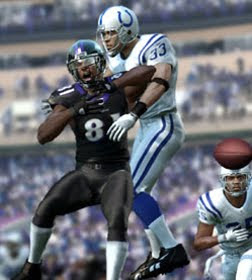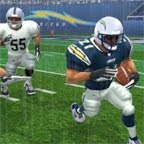 American football has always been popular in the U.S. as a variation of rugby and association football. In the late 19th and early 20th centuries, collegiate sports adopted the game and professional football followed at the turn of the century. So, it stands to reason that football games that simulated the sport became just as big.
American football has always been popular in the U.S. as a variation of rugby and association football. In the late 19th and early 20th centuries, collegiate sports adopted the game and professional football followed at the turn of the century. So, it stands to reason that football games that simulated the sport became just as big. In 1949, Norman Tudor, president of Tudor Electric Games, revolutionized a football simulation by using vibrations to move players down the field. You can find an enhanced version of Electric Football here. Then, in 1977, the Handheld Football Game from Mattel became the rage, pitting a lone running back against scores of "red dash" defenders.
One year later, Atari quickly followed suit with Xs and Os as players in a tabletop version that would later be introduced to home gaming systems. Here's what the first football video games looked like before migrating to home entertainment.
After Atari, sports game designers made several leaps forward, as fast as operating systems would allow it. As football evolved however, the game play became more cumbersome, adding hundreds of plays that required players to click through ever-increasing play books. Some people spent as much time planning their plays as playing the game.
The newest next step for football simulation, Madden NFL 11, changes that. EA Sports' advanced Game Flow system allows the program to pick the plays. This shortens play time because players invest less time looking at the playbooks. It simplifies, but doesn't lock you down.
Was Game Flow Everything Everyone Expected?
There has been some backlash, especially from the Madden NFL 10 crowd. But it's not nearly as aggressive from the transition from 9 to 10. The reason seems pretty simple. The Game Flow feature doesn't really get in the way.
It's optional, and players can turn it off or toggle back and forth between Game Flow and calling plays. And, if they don't call the play, they can always call an audible or route individual players to create additional variations.
The primary benefit of Game Flow is that more people might want to play. There are several multi-player options that help make this possible. In addition to going head-to-head, up to four players can play on the same team, earning points on the plays they make. Veteran players can take care of the play calls and heavy lifting, while the other players execute their own moves and participate. Check it out.
As the review says, for most gaming systems, there are the improved animations and locomotion. Locomotion refers to how naturally the players move, especially when they want to change direction. On the Wii, animation hasn't caught up as much as locomotion. It's very similar to last year's graphics. However, point and pass makes the experience well worth it.
Point and pass refers to the ability to point at the intended receiver on the screen rather than relying on buttons. It's also why the game landed here. Several Wii features make the gaming experience less static. Point and pass is one. Flicking passes is another (gestured movements). And shaking the remote to help runners make power moves is yet another.
Madden NFL 11 For The Wii Kicks A 3.2 On The Liquid Hip Richter Scale.
 Madden NFL 11 features a nice progression for football gaming, but it's not an evolution as much as it's a next step. Somewhere along the way, Madden football has become a chemistry set with Electronic Arts in charge of the mixture. What that means is that some folks won't feel the mixture is right. And sometimes, they're right. When players case players who don't have the ball on occasion, you have to wonder.
Madden NFL 11 features a nice progression for football gaming, but it's not an evolution as much as it's a next step. Somewhere along the way, Madden football has become a chemistry set with Electronic Arts in charge of the mixture. What that means is that some folks won't feel the mixture is right. And sometimes, they're right. When players case players who don't have the ball on occasion, you have to wonder. One thing you don't have to wonder about is if adding Gus Johnson was a good call. By all accounts, Johnson is cool.
You can find the game on Amazon or get Madden NFL 11 direct from Electronic Arts. Both carry the game for all operating systems. The benefit in visiting Electronic Arts right now is that it has a 50 percent off sale through Sept. 14 on select titles.
![Liquid [Hip]](https://blogger.googleusercontent.com/img/b/R29vZ2xl/AVvXsEjAFBQPqS7J0-rrttNoRYSsuwIePPZf4Nq6sqDioK1zzVQXJIQXKzq_NVNI4n6h3inuRQFBKOcJeZeSufkdHHIOxbSWyBjTjTxgKEQGyPzdwvkEEeECh4bI5YEGk4RWGUINSd7vulPQsCA/s1600-r/liquidhip.jpg)